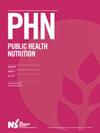24 至 48 个月时儿童家庭食物供应量的纵向变化以及与食物和营养素摄入量的并发关系
IF 3
3区 医学
Q2 NUTRITION & DIETETICS
引用次数: 0
摘要
目标:描述幼儿期家庭食物供应量的变化,包括经修正的、对发育敏感的肥胖评分,并确定家庭食物供应量是否与儿童的食物和营养摄入量同时、长期相关:描述幼儿期家庭食物可获得性的变化,包括修改后的发育敏感性肥胖评分,并确定家庭食物可获得性是否随着时间的推移与儿童的食物和营养素摄入同时相关。设计:为实现研究目标,我们从 "STRONG Kids 2 "纵向出生队列中提取了数据。家庭食物可用性通过家庭食物清单(HFI)进行评估,包括 15 个食物类别(如水果、蔬菜)和 3 个肥胖评分(1 个原始评分和 2 个修改评分)。食物和营养素摄入量通过 "食物频率调查表"(Block Food Frequency Questionnaire)进行测量,包括 27 种食物类别和 18 种营养素(如维生素 A 和 C、蛋白质)。HFI和FFQ分别由训练有素的研究人员或母亲在24、36和48个月时完成。采用重复测量方差分析和斯皮尔曼相关分析来实现研究目标。地点:美国伊利诺伊州中部美国伊利诺伊州中部。参与者:468 名儿童:468名分别在24、36和48个月大的儿童。研究结果随着儿童年龄的增长,营养成分较低的食品和致肥胖食品及饮料的供应量也在增加,营养成分较高和较低的食品的供应量与儿童的食物和营养素摄入量有关。3 项致肥评分与能量、饱和脂肪、添加糖和甜食千卡热量的摄入量呈相似的正相关。结论这些研究结果为了解幼儿期家庭食物供应的变化及其与食物和营养素摄入的关系提供了新的视角。还需要进一步关注家庭食物供应的前因(如建筑环境、购买行为)和后果(如儿童饮食质量、体重)。本文章由计算机程序翻译,如有差异,请以英文原文为准。
Longitudinal Changes in Home Food Availability and Concurrent Associations with Food and Nutrient Intake Among Children at 24 to 48 Months
Objectives: To describe changes in home food availability during early childhood, including modified, developmentally sensitive obesogenic scores, and to determine whether home food availability is associated with food and nutrient intakes of children concurrently, over time. Design: Data were drawn from the STRONG Kids 2 longitudinal, birth cohort to achieve the study objectives. Home food availability was assessed with the Home Food Inventory (HFI) and included 15 food groups (e.g., fruit, vegetables) and 3 obesogenic scores (1 original and 2 modified). Food and nutrient intakes were measured using the Block Food Frequency Questionnaire and included 27 food groups and 18 nutrients (e.g., vitamins A and C, protein). HFI and FFQ were completed by trained researchers or mothers, respectively, at 24, 36, and 48 months. Repeated measures ANOVAs and Spearman correlations were used to achieve the study objectives. Setting: Central Illinois, United States. Participants: 468 children at 24, 36 and 48 months of age. Results: Availability of less nutritious foods and obesogenic foods and beverages increased as children aged, and availability of both nutritious and less nutritious foods were associated with child food and nutrient intake. The 3 obesogenic scores demonstrated similar, positive associations with the intake of energy, saturated fat, added sugars, and kilocalories from sweets. Conclusion: These findings offer novel insight into changes in home food availability and associations with food and nutrient intake during early childhood. Additional attention is needed examining antecedents (e.g., built environments, purchasing behaviors) and consequences (e.g., child diet quality, weight) of home food availability.
求助全文
通过发布文献求助,成功后即可免费获取论文全文。
去求助
来源期刊

Public Health Nutrition
医学-公共卫生、环境卫生与职业卫生
CiteScore
6.10
自引率
6.20%
发文量
521
审稿时长
3 months
期刊介绍:
Public Health Nutrition provides an international peer-reviewed forum for the publication and dissemination of research and scholarship aimed at understanding the causes of, and approaches and solutions to nutrition-related public health achievements, situations and problems around the world. The journal publishes original and commissioned articles, commentaries and discussion papers for debate. The journal is of interest to epidemiologists and health promotion specialists interested in the role of nutrition in disease prevention; academics and those involved in fieldwork and the application of research to identify practical solutions to important public health problems.
 求助内容:
求助内容: 应助结果提醒方式:
应助结果提醒方式:


